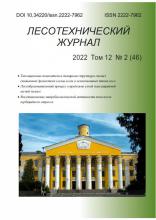Tomsk, Russian Federation
Tomsk, Tomsk, Russian Federation
g. Schuchinsk, Russian Federation
g. Tomsk, Russian Federation
In the subzone of the southern taiga in the territory of the Tomsk region trial plots in forest cultures under the canopy of the forest have been laid, the reconstruction of low-value plantings and subsequent crops has been done. Biometric indicators have been studied and a comparative analysis of three types of plantations has been made. It is revealed that the growth of artificial plantations of Siberian stone pine is largely influenced by competition from adult trees in the main canopy in sub-cultures and in artificial plantations created during the reconstruction process. The preservation of sub-negative cultures has varied from 55.6 to 64.4% at 43 years old age and has been 59.8% at 32 years old age. Sub-negative plantations on the test plot with greater density have considerably lagged behind in growth from the sites with lower density with other identical growing conditions and age. Preservation of forest plantations created by reconstruction in areas without a main canopy has amounted to 72.6%, on a plot with an adult stand - 46.8%. The diameter of the trees on the reconstruction without the main canopy has been 2.1 times different, the height - 1.8 times in favor of the plantations in the area where the low-value plantation have been cut down. In subsequent plantations, in those test plots where pure pine tree plantations have been preserved, the height and diameter of the trees has been also greater than those in the samples with the existing admixture of hardwoods. In general, subsequent plantations significantly exceed the growth of subordinate and reconstructed crops. The growth of sub-cultures is significantly affected by the competition of the root systems of adult plants of the main canopy, shading and lack of nutrients.
subordinate crop, reconstruction of low-value plantations, subsequent plantations, Siberian stone pine
1. Gabeev, V.N. Opyt razvedeniya kedra v lesostepnoy zone Zapadnoy Sibiri [The experience of breeding cedar in the forest-steppe zone of Western Siberia] Puti uluchsheniya lesoustroystva i lesopol'zovaniya v Zapadnoy Sibiri [Ways to improve forest management and forest management in Western Siberia]. Novosibirsk, 1975, pp.157-164.
2. Krylov, G.V., Gabeev V.N. Tseli i zadachi sozdaniya kul'tur kedra [Goals and objectives of creating cedar crops] Vyrashchi-vanie posadochnogo materiala kedra sibirskogo v pitomnikakh [Cultivation of Siberian cedar planting stock in nurseries]. Kemerovo, 1974, pp. 9-14.
3. Loskutov, R.I., Polikarpov N.P. Podgotovka semyan k posevu [Preparation of seeds for sowing] Vozobnovlenie v lesakh Sibiri [Resumption in the forests of Siberia]. Krasnoyarsk, 1965, pp. 163-185.
4. Loskutov, R.I., Polikarpov N.P. Podgotovka semyan k posevu [Preparation of seeds for sowing] Vozobnovle-nie v lesakh Sibiri [Resumption in the forests of Siberia]. Krasnoyarsk, 1965, pp. 186-224.
5. Danchenko, A.M., Danchenko M.A., Myasnikov A.G., Bekh I.A. Kedry Rossii [Cedars of Russia]. Tomsk, Izdatel'skiy Dom TGU Publ., 2016. 300 p. EDN: https://elibrary.ru/OTEUZT
6. Chizhov, B.E. Regulirovanie travyanogo pokrova pri lesovosstanovlenii [Regulation of the grass cover during reforestation]. Moscow, VNIILM Publ., 2003. 174 p. EDN: https://elibrary.ru/QKVWJL
7. Bekh, I.A., Danchenko A.M. Formirovanie kedrovnikov razlichnogo tselevogo naznacheniya: uchebnoe posobie [Formation of stone pine forests for various special purposes: textbook]. Tomsk, Tomskii Gos. Univ. Publ., 1997. 49 p.
8. Sennov, S.N. Rezul'taty dlitel'nykh opytov s rubkami ukhoda za lesom [The results of long experiments with forest care sponges]. Lesnoe khozyaystvo [Forestry], 2001, no. 2, pp. 28-29.
9. Pobedinskiy, A.V. Izuchenie lesovosstanovitel'nykh protsessov [Studying reforestation processes] Moscow, Nauka Publ., 1966. 64 p.
10. Melekhov, I.S. Biologiya, ekologiya i geografiya vozobnovleniya lesa [Biology, ecology and geography of forest renewal] Vozobnovlenie lesa [Renewal of the forest]. Moscow, 1975, pp. 4-22.
11. Anuchin, N.P. Lesnaya taksatsiya: uchebnik dlya VUZov. 5 izd [Forest taxation: a textbook for universities. 5 ed.]. Moscow, Lesnaya promyshlennost' Publ., 1982, 352 p.
12. Kabanova, S.A. Izuchenie lesnykh kul'tur sosny, sozdannykh v protsesse rekonstruktsii malotsennykh nasazhdeniy v Gosudarstvennom natsional'nom prirodnom parke «Burabay» [Studying pine forest cultures, created during the reconstruction of low-value plantations in the State National Nature Park "Burabai"]. Vestnik Tomskogo gosudarstvennogo universiteta [Bulletin of Tomsk State University], 2011, no. 347, pp. 162-165. EDN: https://elibrary.ru/NUXLNJ
13. OST 56-69-83. Ploshchadi probnye lesoustroitel'nye. Metod zakladki [OST 56-69-83. Areas of trial forest inventory. Bookmark Method]. Prikaz Gosleskhoza SSSR ot 23.05.1983 №72 [Order of the State Forestry of the USSR from 23.05.1983, no.72]. Moscow, TsBNTI Gosleskhoza SSSR Publ., 1984.
14. Danchenko, M.A., Kabanova S.A. Ekologo-ekonomicheskie osnovy ustoychivogo lesopol'zovaniya [Ecological and economic bases of sustainable forest management]. Almaty, 2011, 122 p. EDN: https://elibrary.ru/YLOTJZ
15. Mori, A. S. Retention forestry as a major paradigm for safeguarding forest biodiversity in productive land-scapes: A global meta-analysis. Biological Conservation Publ., 2014, no. 175. pp. 65-73.
16. Pawson, S. M., Brin A., Brockerhoff E. G., Lamb D., Payn T. W., Paquette A., Parrotta J. A. Plantation for-ests, climate change and biodiversity. Biodiversity and Conservation Publ., 2001, no. 322, pp.1203-1227.
17. Richards, A. E. Forrester D. I., Bauhus J., Scherer-Lorenzen M., The influence of mixed tree plantations on the nutrition of individual species: a review. Tree Physiology Publ., 2010, no. 30, pp. 1192-1208. DOI: https://doi.org/10.1093/treephys/tpq035; EDN: https://elibrary.ru/MZQYEX
18. Nagaike T. Current Status and Perspectives of Mixed Tree Plantations. Journal of the Japanese Forest Soci-ety Publ., 2012, no. 94, pp. 196-202.












